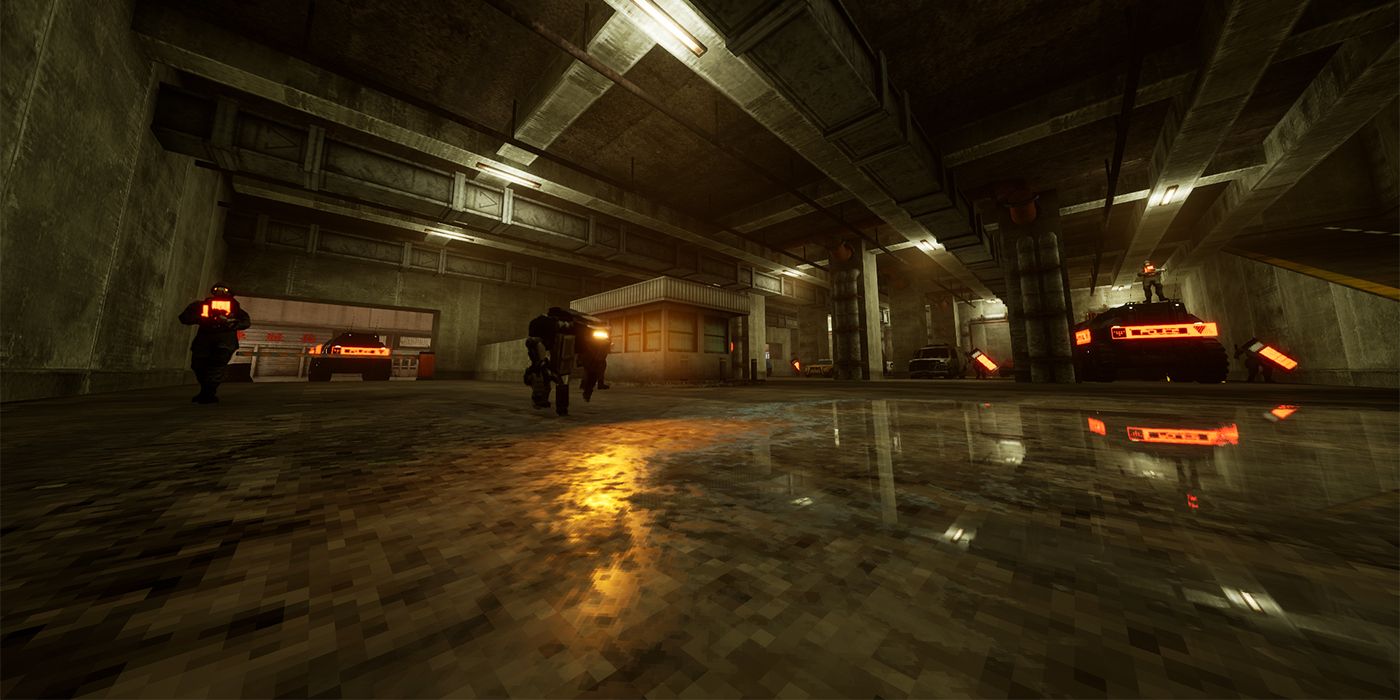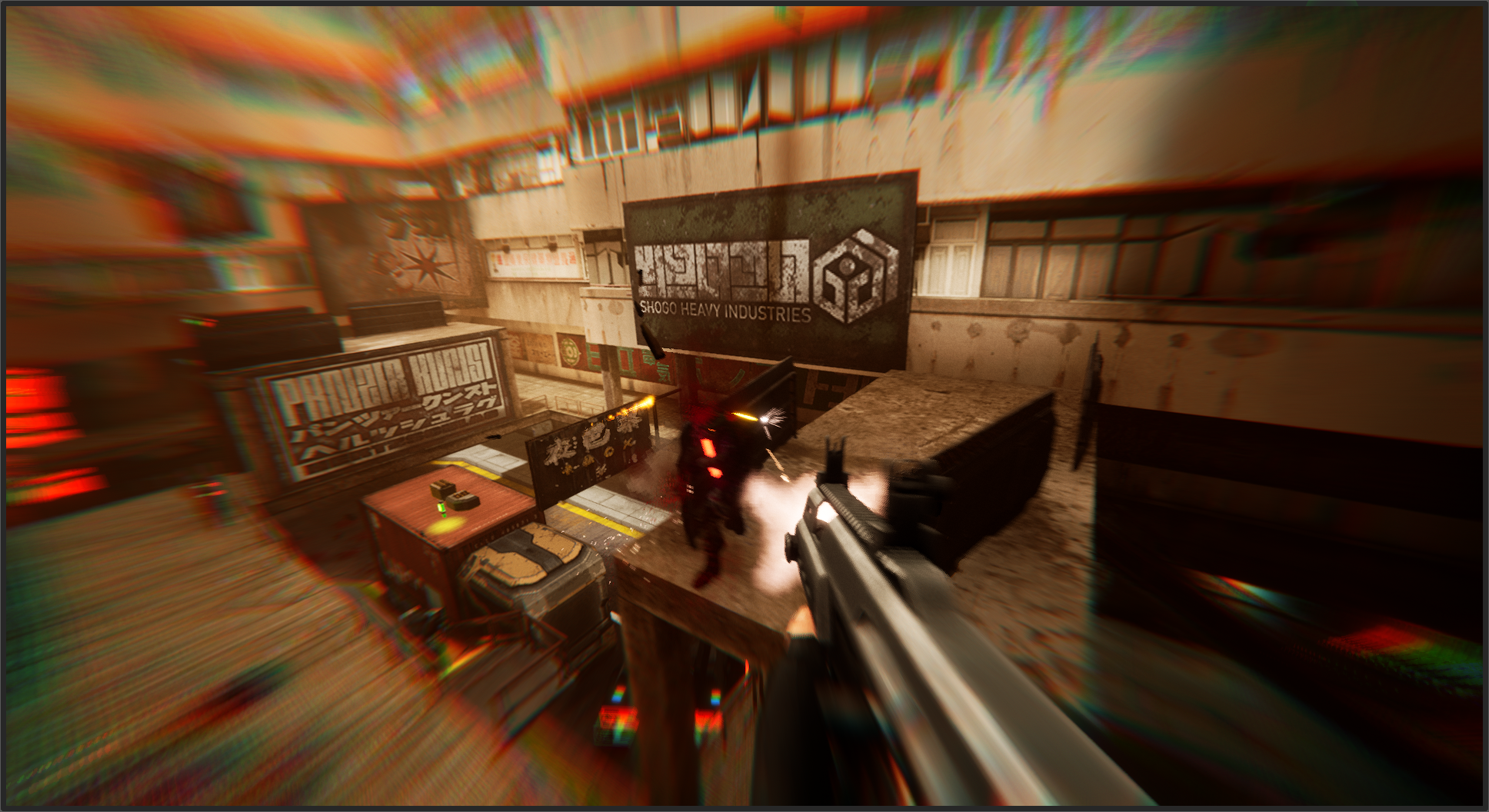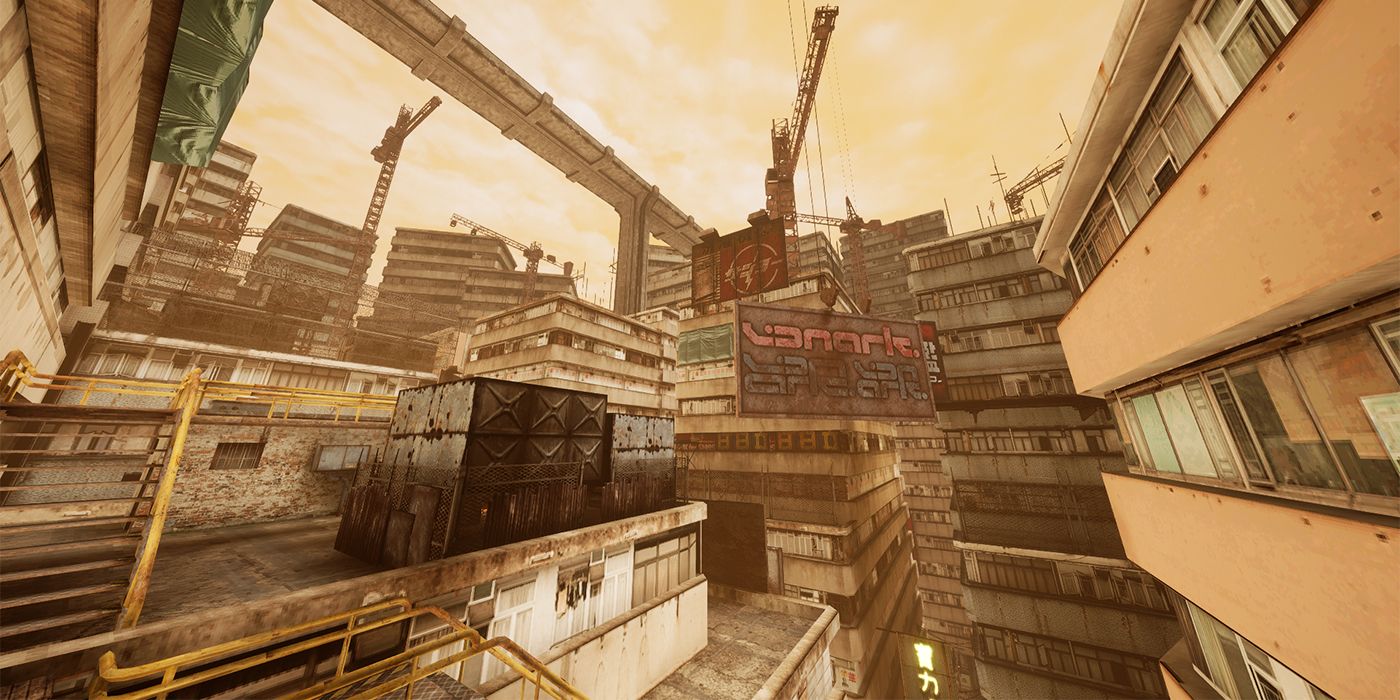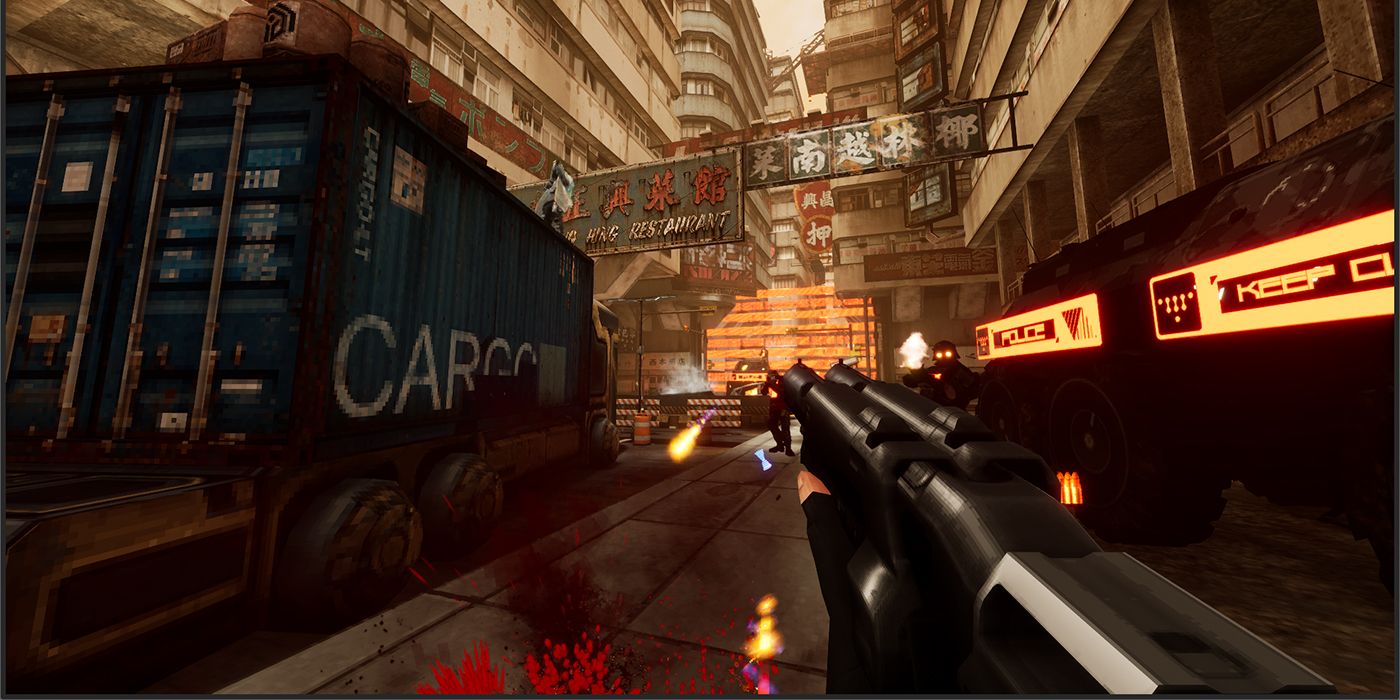Retro game design requires developers to strike a careful balancing act. They must simultaneously appeal to gamers' sense of nostalgia while living up to their rose-tinted memories of the genre, which are often larger than life. Trying to reinvent a legendary genre of fiction simultaneously, however, is akin to juggling while walking a tightrope. But Carlos "Revel" Lizarraga, co-developer of the indie, retro FPS Sprawl aims to do exactly that.
Game Rant recently spoke to Lizaragga about his personal connections to the cyberpunk genre, Sprawl's numerous influences, the importance of emergent gameplay, and a time when twitchy shooters dominated PC gaming. This transcript has been edited for clarity and brevity.
Q: Can you start by introducing yourself and telling us what your favorite piece of cyberpunk media is?
A: Actually, that’s an easy question! My name is Carlos Lizarraga. I’m better known as “Revel.” I’m one of the co-developers on the retro movement-focused shooter, Sprawl. Which is, in of itself, a reference to the famous works of William Gibson. And my favorite piece of cyberpunk media is Ghost in the Shell, 1995.
Q: You mentioned the title is a reference to William Gibson’s Sprawl Trilogy. Are you a fan?
A: Yeah! I am a big fan of Gibson. Gibson was absolutely instrumental in opening my imagination to… the idea of synchronicity, you know? How his stories were developed independently from Blade Runner, they had the same sort of tinge going on, they were telling the same sort of story, shared the same group of influences, just in a different way and with absolutely no knowledge of each other. And before Gibson published Neuromancer, he said "I want to see that movie," and when he saw it, he said "I’m f*****. My book is dead."
Q: How would you introduce Sprawl to players who have yet to hear of it?
A: Sprawl is like the games you remember playing on the computer in the 90s or in the early 2000s, as you remember them, and not as they actually were. It’s also a logical extension of the guiding design principles of those games. Games back then were focused on high-speed movement, the action was very frantic… but with the advent of consoles, and controllers, a whole set of principles went away. You had to slow things down to let people aim and move appropriately—you know, the whole floaty movement thing that happened because of Halo.
So, hopefully, Sprawl is a return to that form, as well as an extrapolation of it. Like, that type of game has gotten very popular as of late. So seeing that, we’re like, "How can we take that to the next level?" Because if you want to play Quake, you can go play Quake again. Or any one of the twenty-five million clones that have been released since then. So, we were more concerned with why people play these games. You know, the fast movement, straight into the action, adrenaline-pumping… and lots of emergent gameplay. We sort of doubled down on that. We took everything that made those games fun, threw in wall running, weapon combos… took everything to the next level.
Q: Bullet time and wall running feel natural for a cyberpunk title. Without spoiling anything, can you tell us if players will unlock or encounter other cyberpunk mechanics?
A: No. We made it very clear to ourselves from day one, that the game you’re gonna be playing, is definitely a game of mastering the mechanics. At its core, the game is very easy to pick up. And at first, you’re just not going to be very good at it. But as you play, you start to unlock things in yourself: understanding how to take advantage of the mechanics. You see those core relationships and see "if I do this bullet time in combination with this kind of wall run, and I move my mouse just in the right way, I can pull something really flashy that is beneficial in combat." It’s not a question of “you get a pick-up three levels into the game and it’s gonna unlock cyberhacking.” We didn’t want to make that type of game. We wanted a game that rewarded you for you, rather than just throwing new features at the player. That’s what all of our favorite games did.
As far as unlocks go, you’re going to get new weapons. And the new weapons are gonna change up the metagame exponentially. The sort of core gameplay loop you experience at the beginning is going to flip over, as the resource economy tips in your favor. The best way to explain it is: Sprawl is a game that looks very shallow, that pretends to be very shallow. But there is a lot going on underneath the hood.
Q: How did you develop the idea to supercharge cybernetic augmentations with enemy blood?
A: Ah! That, fundamentally, is not the kind of thing that makes sense, and more follows game logic. But regardless of that, I have come up with my own sort of reasoning why that works. There is this idea that in the far dystopian future, weapons are tied to the people who use them. Almost a form of gun control where… Have you seen the Judge Dredd movie with Stallone from the 90s? Where the guy picks up the wrong gun and it just...blows him up? Imagine something like that. If you blow someone’s head off, the chip in their head governing weapons and health vials is like ‘error: not found,’ allowing you to pick them up. So that’s the head cannon.
But as far as making logical sense from day one? This was a gameplay decision to make things more fun. We want to reward people for doing flashy things. Cutting a guy in half with a sword, blowing heads off with a pistol… that’s fun, you know? I can figure out why it makes sense later.
Q: How large is the arsenal in Sprawl? And what are some of your favorite weapons?
A: Oh, totally! It’s a 'Standard Id Software Arsenal,' taken a step further. Everything has some subversion of what typically makes this gun part of the retro-shooter weapon palette. You have the melee weapon, pistol, assault rifle, SMG, the shotgun, the grenade launcher, rocket launcher, rail gun, and the big ‘f*** off' weapon. Those are kind of the bread and butter of what made those games, those games.
Everything we do with those weapons is a little different than what you would expect, though. In your entire arsenal, the only gun that’s going to be 100% accurate, and also 100% responsive from the second you click the mouse, is gonna be the pistol. So you always have to constantly switch back to this gun when you want to pick somebody off without wasting ammo for your power weapons.
My favorite, I think of all of them, is the shotgun. I don’t know if you’ve seen the videos where I get a little flashy, but it has this mechanic that works like rocket jumping. Where you can jump, shoot the floor, and if you time it correctly, you’re launched into the air.
And you can work this into weapon combos because every weapon comes out within more or less the first few frames of animation. So if you get surrounded by a whole bunch of enemies, and it seems like you’re about to be screwed, you can flip the table very very easily. Shotgun jump yourself into the air, maybe move into a wall run, or do a 180, pull out your grenade launcher, and blow all those enemies up.
It creates a lot of fun situations with emergent gameplay, and that is really our guiding principle. Emergent gameplay is what gave Quake its longevity—you know, in addition to the modding scene. It’s still what makes certain games today stand out. We can see the recent popularity of things like… take Fortnite for example. They expected people to make forts, and then you see kids pulling off incredibly crazy, complex s***.
Even right now, with the game Slipgate, which is absolutely taking off, I would eat my own hat if that aspect of emergent gameplay wasn’t the reason. You give people these mechanics, and they find new ways to exploit them, maybe not as the developer originally intended, but they are really fun and provide the player an opportunity to interject their personality into the game. And at the end of the day, that’s what makes games fun, right? It’s a theory, but I like to think I’m pretty on point with that logic.
Q: You mentioned Quake and Id Software. What other shooters influenced the mechanical feel of Sprawl?
A: More than anything, I’d say anything that came out on the Source engine. The weapon play in those titles, the feel of movement, those are my main influences, and I know they are really important to my co-developer, Hannah, too. I was a member of the ‘B-hop’ community, the ‘surf’ community, and the ‘rocket jump’ community. Which are all just exploitations of the movement mechanics of those games. The idea of building a game around these sorts of principles seems enticing. I know there’s something special there. There’s a myriad of other influences as well. Like Mirror’s Edge. Titanfall. But if I had to single things out, it would be everything that came out on Source. Half-Life. Counter-Strike. Team Fortress.
Q: From Cyberpunk 2077, to Ghostrunner, to The Ascent, Cyberpunk’s popularity is blowing up in video games right now. Why do you think that is?
A: I predicted this very strongly in 2016, but I was very wrong about the timing. We thought it would happen earlier. When we saw Ghost in the Shell was getting a live-action adaptation, we said, "This is gonna be the cyberpunk renaissance we’ve been waiting for!" Because there was a dry spell for a long time. It just felt like there wasn’t anything interesting going on in the genre. But there were a whole bunch of kids on the internet like me, who grew up on this stuff, and we kind of found each other. We realized that we had that shared interest, and we knew it was going to come back. So as far as it actually happening, I do agree, there is a cyberpunk renaissance going on now, and I am very, very happy that it is here.
I remember when Prey 2 got canceled. The game world was basically, "that’s just Blade Runner." I was craving a game that looked and felt like that, and then we never got it. I played Cyberpunk 2077 and I absolutely loved it. Basically, everything I could consume in the genre, in rapid succession, to get my fix. But yes. It’s coming back, and I’m very happy about that.
I think cyberpunk is making a resurgence because of how poignant the themes that the genre deals with are, and how relevant they are to today. When Gibson wrote Neuromancer, he predicted a lot of things. It was speculative sci-fi. Today? We’re actually living it. We’re all cyborgs. External memories stored on touch screen devices that amplify our daily life. Perception is entirely molded by these memories captured, modified, tuned. We actively re-write our day-to-day experiences, and build entire facades around them, allowing them to influence others perceptions of us. Simulacra and simulation.
Q: Do you have any cyberpunk hidden gems? Lesser known games, or other media that people should check out?
A: Eye: Divine Cybermancy. That team wore their influences on their sleeve. They were adamant about the fact that they enjoyed things, and they built that entire game around showing off their influences., from Warhammer to Ghost in the Shell. I think there is a distinction between eastern cyberpunk and western cyberpunk, and Eye definitely has a bit of both. And that got me hooked because I hadn't been able to play a game like that. Ever. It has a lot of issues, don’t get me wrong, but it has a lot of soul. It tries real hard, and once you get into it, it’s a lot of fun. It is my number one recommendation, but it is not for everyone. A lot of people have been like, "Why did you force me to buy this?" Because it’s good! Just give it a shot!
Q: In your opinion, what are the most important qualities for a cyberpunk game to have?
A: Cyberpunk as a genre, poses philosophical questions about the ramifications of cyberization, the destruction of the world… but I think the core guiding principle is identity. Your relationship with yourself. How your physical ‘avatar’ relates to the world around you. But it’s been 50 years since the picture of the retrofuture was painted. So where else can we take it? The neon color palette isn’t reflective of what the future is going to look like. At least I don’t think so. It’s gonna be more somber. We’re gonna destroy the world. What will that look like? I think that’s a far more interesting portrait of what the genre can be.
Q: You mentioned you played Cyberpunk 2077 and enjoyed it. Has the hype and reception of that title affected the development of Sprawl in any respect?
A: No. They are completely, completely different games. It has as much bearing on our game as Skyrim does. Don’t get me wrong, it’s a cyberpunk title. But it follows that western lineage of the 80s, and there’s not much else going on there.
That said, I have walked around the world and found it incredibly immersive. It was just unfortunate what happened with the leadership, and everything else going on over there. My heart goes out to that team. You can tell there was a lot of heart that went into that thing. You could feel the passion that went into the project. But to wrap it up nicely and answer the question: everything about Cyberpunk 2077 has no bearing on what we’re doing.
Q: Sprawl’s trailers on Steam have a number of subtle nods to other cyberpunk properties like Ghost in the Shell, Blade Runner, The Matrix. How do you strike a balance between homage and originality?
A: I love the idea of contrast: putting things in the frame, and then subverting them. And so that is very much what we’re doing with Sprawl. Like, at the end of the day it is fanboyism. I’m not gonna pretend I can paint a picture better than somebody else. Not in any sense. Not at all. It’s mostly that… there hasn’t been a game that looks like ‘95's Ghost in the Shell. And we don’t want to just rip off that look. We are gonna completely flip it on its head.
We’re hoping to capture the most accurate picture of what the future is going to look like. It’s gonna look like Kowloon, it’s going to look like Hong Kong. In our trailers, you can see technology encroaching on the world, like the shrines and temples that are surrounded by wires. But we have plans for the later levels of the game and...it’s not like anything you’ve seen in the genre before. This is not Blade Runner. This is not Neuromancer.
Q: Cyberpunk is an extremely striking aesthetic, but beneath the chrome and neon, it can also be a very cerebral genre, covering everything from transhumanism, to economic disparity, to existential philosophy. Does Sprawl’s story play with those themes?
A: So here’s the thing. Just as a Sprawl is a game that is masquerading as a simple game, it’s also a story that is masquerading as a simple story. For people who just want to go in there and blow s*** up: you can. You’ll have a very surface-level understanding of the game, but you’ll get a satisfying conclusion.
The story is totally optional. You can read about the world, or piece together the narrative from environmental storytelling. There are terminals in the game world that can completely change your impression of what happened, and I know I’m being a bit vague, but I don’t want to ruin it for people who want to dive into it. But again, it’s completely optional. If you don’t give a f*** about the story, it doesn’t give a f*** about you. We’re never gonna lock you in a room, or make you sit somewhere for longer than ten seconds, except for the very beginning. If you want to engage the story, you will discover a lot of lore.
Q: According to Sprawl’s Steam page, players are guided by a mysterious voice. Can you give us any hints about your ‘passenger’ without spoiling anything?
A: Um. Look for those terminals. [Laughing.] Think… what you think he is. I can’t give any more than that. He can be exactly what you want him to be.
Q: How are you approaching the sounds of Sprawl? Are there any specific genres or styles shaping the soundtrack?
A: It is a hodgepodge of influences. And again, the reason goes back to that picture of the retrofuture. The soundtrack for every cyberpunk game still sounds like Perturbator or 80s synthwave, and it’s like, "Why are we still stuck here?" And obviously, it’s a genre that was born in the 80s. Using synthesizers to create ambiance and soundtracks for movies, and that was extremely forward-thinking and new. But why are we still stuck there? There’s so much else you can do. There’s an extremely broad sound palette. Again, there’s no problem with that—I love Perturbator and 80s synthwave, but there’s room for more in cyberpunk. And you’re not going to hear a single track in Sprawl that sounds like that.
We’re taking very human elements of sound and overlaying technology over that. For example, chants that are just a little out of tune, not overproduced so they sound like pop music, and layered on top of that we have these syncopated tribal drum patterns, and then use very powerful electronic sounds to tie everything together.
There was a brief moment where anime, cyberpunk, video games, and dance music were all kind of hanging out together because they were kind of the artistic rejects. So dance music borrowed from anime, and anime adopted more cyberpunk themes. They kind of all grew up together. And there is a lot to explore there. I’m very excited to say we’re taking things in a new direction.
Q: How long has Sprawl been in development? How did the project start?
A: It’s a nebulous question. I have sketches of environments from 2015 that I made in the Source engine. I wasn’t really planning on making a game with them. I wasn’t really doing anything with them. It has a basis in things that both Hannah and I love. COVID was what inspired me to just make it. I had the opportunity to do something different, something fun now. I can finally chase a dragon I’ve been wanting to chase since I was twelve. At the beginning, all I knew was that this would be called Sprawl. I didn’t even know it would be a game yet. I just knew it would be cyberpunk, and it would be called Sprawl.
So while I was working on my own retro shooter, Hannah was doing something absolutely mind-blowing with movement mechanics, wall running, etc. She reached out and tried to convince me to work together. We had this electrifying conversation about video games, music, and cyberpunk as a whole, and we decided to fuse our projects. And I think this was… I want to say late August, early September of 2020. That was when we started working together. Like, let’s do this, let’s actually do this.
Q: What is the greatest challenge you’ve had in development to date?
A: So we’re building a game that is introducing a whole new axis, the Z-Axis. And as a designer, you have to recondition the player to look up. Valve has a famous quote along the lines of “If you can figure out how to make players look up, please let us know.” There’s a lot of incentive to do platforming and stuff like that. But that has definitely been the biggest challenge. Building game worlds that are big and sprawling, but not flat. We want to incentivize using mechanics in fun ways. And I think, after doing a few tests, we have figured that out.
Q: Any plans for early access, or a Kickstarter?
A: No. We are announcing our publisher next weekend, at 3D Realms’ Realms Deep event. But we have no intention of putting out the game in any way that it is incomplete. The whole game is a whole cohesive project.
Q: Do you see Sprawl as a self-contained game, or do you have plans for post-launch support, such as DLC?
A: Post-launch support, definitely. As far as it being DLC missions? I don’t want to rule that out. But we are looking more into adapting the game for multiplayer, new maps, race modes, things like that. There is a lot of potential for us to keep supporting the game after release, and I intend on doing that. As far as a sequel? We don’t have plans at the moment, but we have to see what happens.
Q: What other titles are you currently playing for inspiration and enjoyment?
A: Let’s actually open the Steam library and see… I am trying Necromunda: Hired Gun, because it’s from the same developer of Eye: Divine Cybermancy. And I’m giving it a shot, chipping away at it, but more and more I go back to the same things I played growing up. Like I’ll reinstall Quake 2, or Blood, or other titles I played to death growing up. But the number one game I play right now to relax and de-stress is Doom: Eternal. It is a brilliantly, brilliantly designed game. I haven’t played The Ascent yet, but I want to. It’s on my wishlist. I may go play it after this call. But that’s pretty much it. I keep going back to the same things I played back in the day. I’m currently doing a Deus Ex replay.
Q: Is there anything else you would like readers to know?
If you are a fan of Doom Eternal, or any of the other influences I’ve mentioned, or emergent gameplay, you are gonna love Sprawl. If you want to approach a game with the mentality of "how can I do things differently than the developer intended," you’re gonna love Sprawl. The game is ultimately a sandbox, and we are giving you the tools to explore that sandbox. You’ll find different kinds of weapon combos and different movement abilities, and once you get there… It is satisfying. It is very, very satisfying. I am saying that as a developer, but now that we’ve had four testers trying out the game… I’ve received messages from every single one of them at 3 AM or other random times, to the effect of “holy f***. The game just clicked. I feel like a badass, and I cannot stop playing.”
[End.]
Sprawl is currently in development for PC. A release date has yet to be announced.




